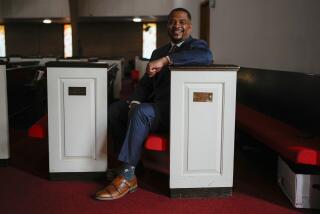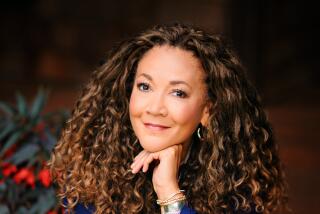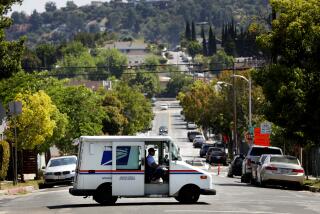Racial Tension Haunts a ‘Nice Neighborhood’
NEW YORK — It is a neighborhood of small shops, corner delis and tidy houses and apartment buildings with statues of saints adorning front-yard gardens.
On summer evenings, families lounge in aluminum lawn chairs and chat merrily with their neighbors, many speaking in their native Italian, as kids play freely in the quiet streets.
But this is also where a gang of white teen-agers, armed with baseball bats and at least one gun, shot to death a black youth who had come to the neighborhood with three companions to see about buying a used car, heightening racial tensions here to their worst level in two years.
Like many ethnic enclaves in northern cities, Bensonhurst, a largely Italian-American community of 152,700 residents on Brooklyn’s southern shore, has rarely, if ever, been noted for being hospitable to “outsiders”--especially blacks and other minorities.
Two decades ago, as the nation sifted the ashes of successive urban riots, academics and many government officials hoped that education and greater integration would break down intolerance in such communities. Instead, the situation may have worsened.
In New York City , for example, there has been an alarming string of violent racial incidents in working class, white ethnic neighborhoods in recent years, including the widely publicized death in 1986 of a black man who was hit by a car while fleeing a gang of whites in the Howard Beach section of Queens and the brutal killing in 1982 of a black man by whites in the Gravesend neighborhood of Brooklyn, near Bensonhurst.
On the eve of a protest march today through Bensonhurst to be led by black activists, attitudes are hard.
“The violence to which blacks have been subjected in New York City surpasses the violence of the Southern cities of my youth,” Herbert Daughtry, pastor of Brooklyn’s House of the Lord Pentecostal Church, said in a recent opinion piece published in the New York Times.
‘Nice Neighborhood’
In Bensonhurst, one 59-year-old resident said Wednesday: “It’s a nice neighborhood--just like any other place in the United States--but we don’t care for black people.”
Nevertheless, residents almost universally reject suggestions by outsiders that racism is a problem in the community.
Many argue that last week’s slaying of 16-year-old Yusuf Hawkins was a case of jealously and mistaken identity more than racism. According to various accounts, the gang of young whites thought Hawkins and his companions were friends of a white Bensonhurst girl whose spurned lover had warned her not to invite blacks and Latinos into the neighborhood.
“This kind of thing never happens,” said Frank Adamo, 32, a newsstand owner, referring to the killing. “This is a neighborhood where whites get along with blacks. We all get along.”
Yet, just two years ago on Christmas Day, two blacks were beaten by a gang of whites in Bensonhurst who allegedly yelled: “This is our Howard Beach!” And in 1983, whites assaulted three black men on their way home through the neighborhood to their jobs at a Coney Island hospital. None of the injuries in either incident was fatal.
What is more, when a group of largely black protesters staged a demonstration last weekend at the site where Hawkins was slain, several white counterdemonstrators held up watermelons and shouted an epithet.
“They shout (the epithet) and then tell everybody they’re not racist,” said Richard Wade, a professor of urban history at City University of New York’s Graduate Center. “They don’t even know they’re racist. That’s the trouble. They don’t know what racism is.”
Bensonhurst’s latest black victim has even been blamed for precipitating the crime. As one young white put it, referring to Hawkins: “Look, he was black. What was he doing in a white neighborhood at 9:30 at night?”
The Rev. Charles Fermiglia, the 30-year-old associate pastor of St. Dominic’s Roman Catholic Church in Bensonhurst, said that racial attitudes in the community are strongly conditioned by the constant barrage of negative portrayals of blacks in the mass media--newspapers, radio, television and movies--and the relative scarcity of any countervailing images.
Nearly half of Bensonhurst’s Italian-American population is made up of immigrants from Italy, many from the strongly traditional regions of southern Italy and Sicily.
“The Italian-American transplanted to this community wants to live in a neighborhood with familiars, people who share his values of family and community and can give him meaning,” Fermiglia said. “The perceptions of blacks gained through the media, unfortunately, is that they are socially disconnected.”
General attitudes in society are magnified in places like Bensonhurst, said Charles Willie, a Harvard University professor of education and urban studies.
“These neighborhoods are acting out the values which they have heard articulated not just by other working-class people but by middle-class people and others” on up the socioeconomic ladder, he said. “The people in Bensonhurst hear the more affluent white opinion-molders talk against the encroachment . . . that blacks and Hispanics are making, and they feel they are doing the right thing.”
Less Recourse
If their actions more often take a violent turn than those by whites in more affluent settings--such as the suburban communities or college campuses that also have experienced a rash of racial incidents in recent years--it usually is because blue-collar whites feel that they have less recourse to institutional systems to protect their interests, Willie said.
The Northeast’s sharp decline in manufacturing jobs--the traditional occupational mainstay of urban, white ethnic communities--together with the ever increasing proportions of blacks, Latinos and Asians in city populations, has given many of these neighborhoods the feeling, rightly or wrongly, that their backs are against the wall, Wade said.
“In the simplest terms, what happens in a place like Bensonhurst is the people who can make it, leave, while those who can’t, stay behind,” he said. “Those involved in these racial incidents are people with marginal jobs or no jobs at all, who haven’t finished high school and only occasionally go to college.
“You have these pockets all over where you have left behind a class of whites who may have already moved two or three times as a result of the expanding ghetto. And now, there’s no place to go. As one person in Bensonhurst was quoted as saying in the paper: ‘They keep pushing so, there’s no place to go but the water.’ ”
The association of blacks with high crime rates is another obstacle to greater acceptance and tolerance, Fermiglia, the priest, said.
Bensonhurst has one of the lowest crime rates in Brooklyn. For example, only 13 murders and 15 forcible rapes were reported in the community in 1988. That compares to 64 murders and 117 rapes in the predominantly black Brownsville neighborhood, which has a population half that of Bensonhurst, and 128 murders and 253 rapes in the largely black Bedford-Stuyvesant community, which has a population of 133,800--18,900 less than Bensonhurst’s.
Fermiglia acknowledged that Bensonhurst’s residents look merely at such statistics and do not take into account the much greater unemployment and other economic and social factors that may be behind the higher crime rates in the black sections.
Old South
He also decries comparisons of Bensonhurst with the South of the Jim Crow era, saying that unlike Dixie during that period, the public officials and civic and religious leaders of the Brooklyn community do not condone or publicly support racism and segregation.
In recent years, Bensonhurst has become home to a small but growing number of Asians and Latinos--chiefly Puerto Ricans--who appear to be relatively well accepted in the community.
“I’ve lived here for two years and I haven’t encountered any prejudice. Well, just a little bit,” said Hae Soo Jeon, proprietor of Yang’s Grocery-Deli on one of Bensonhurst’s bustling commercial strips. “I didn’t even know this was Bensonhurst until the murder happened. I thought I was in a place called Bay Ridge.”
A smattering of blacks are said to live in Bensonhurst as well, and many blacks work in the local shops and businesses, although usually in menial jobs, and at the local post office.
Although some of the blacks who work here say they have had their share of bad encounters and don’t hang around the neighborhood after work, others say their experiences have been virtually problem-free.
“I’ve worked here for two years and never had any trouble,” said Trevor Fuller, 32, who lives in Flatbush and is a delivery man for a monthly Bensonhurst newspaper. “I don’t hang around after work, but if I did, they wouldn’t bother me. Everybody knows (me). Besides, my brother-in-law is Italian.”
Nevertheless, as a white political worker familiar with New York’s blue-collar, white ethnic enclaves says: “Brooklyn and Queens are extremely racist, no matter what anybody tells you. I think it comes from the fact that the majority of whites grow up in segregated neighborhoods, go to parochial schools and have no exposure to minority people of any color, and there’s just an incredible fear of them. In a large part, it’s a fear of the unknown, which seems kind of crazy in 1989.”
How to overcome these fears and create greater racial tolerance and harmony in communities like Bensonhurst remains a big question.
“In some ways, the working class and the poor are paying the price of the unwillingness of the society to solve the economic and social problems” that help feed racial hatreds and animosities, said Richard Simpson, a former Chicago alderman who is now a political science professor at the University of Illinois at Chicago.
Simpson said that the North Side Chicago ward that he once represented boasted a multiethnic and multiracial population that managed to live without the strife normally associated with such neighborhoods because “most people were moving up in society and weren’t threatened by sliding down.”
What is more, “we weren’t threatened by a Cabrini-Green next door,” he said, referring to a deteriorating, crime-ridden Chicago high-rise public housing project near the downtown Loop business district.
“We could even introduce three public housing projects of our own without only a little flak,” he said. “They were the low-rise kind with only 18 units in each of the three buildings, but if you tried that on the northwest or southwest sides, there would be some serious threats or even firebombs.”
Stance by Leaders
Simpson also contends that a lot could be achieved if public officials and community leaders took an open stance against racism and encouraged programs and policies that promoted greater racial understanding and tolerance.
In Bensonhurst, tentative steps have already been made in that direction. The Brooklyn Borough President, Howard Golden, and the superintendent of Community School District 20 in Bensonhurst, promised at a recent news conference to expand the human relations curriculum in the district classrooms.
How much further this kind of activity will go and whether it will help create a better racial climate remains to be seen. But as Elizabeth Galarza, the 32-year-old Bensonhurst mother of four who held the dying Yusuf Hawkins’ hand after he was shot and murmured words of encouragement to him, said: “There are more of us who believe in a positive way and that’s the way we should all go in this neighborhood.”
Intern Silke Fett contributed to this report.
More to Read
Sign up for Essential California
The most important California stories and recommendations in your inbox every morning.
You may occasionally receive promotional content from the Los Angeles Times.










